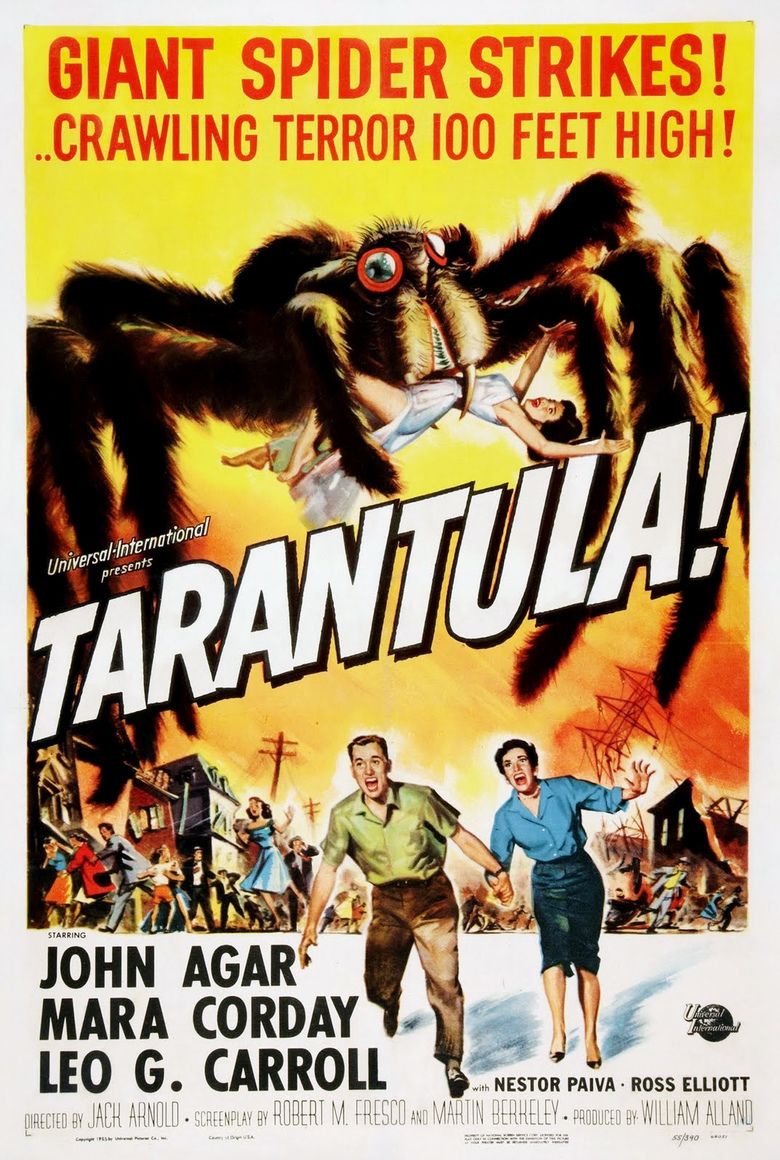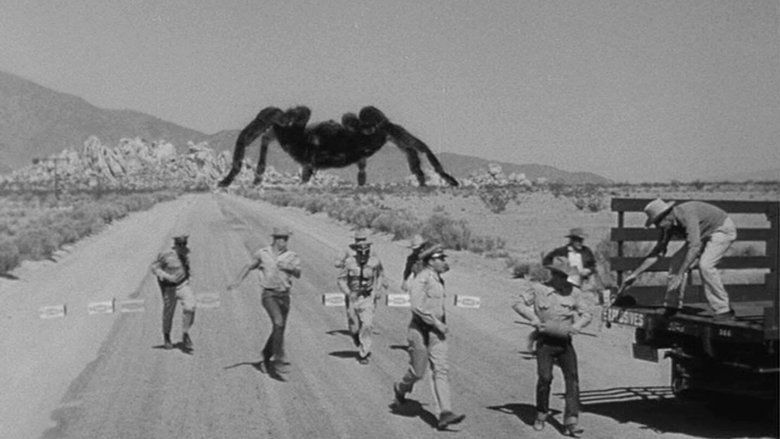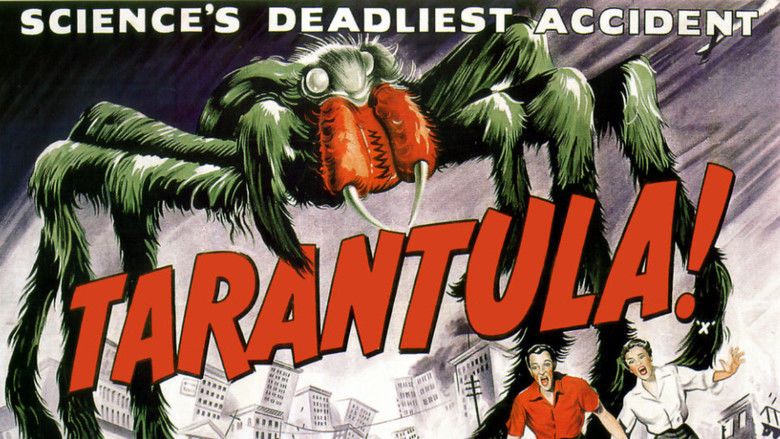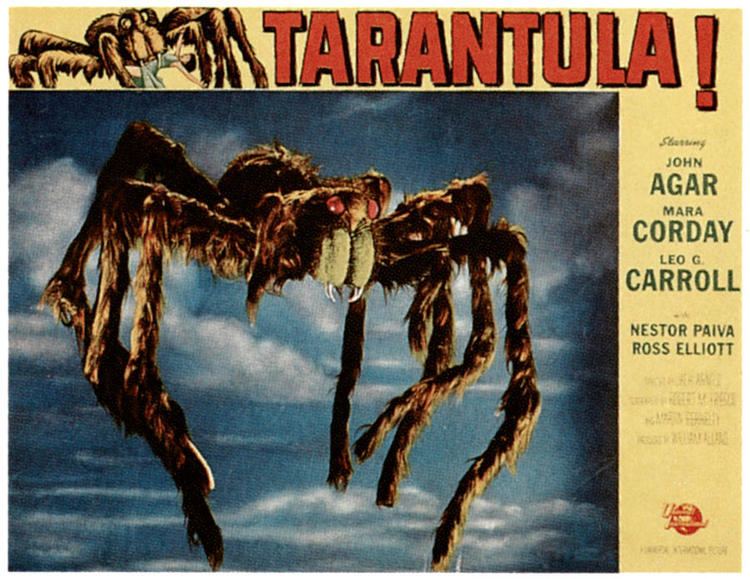Tarantula (film)
6.6 /10 1 Votes6.6
Duration Language English | 6.6/10 IMDb Genre Horror, Sci-Fi Country United States | |||||||||||||||||||||||||||||||||
 | ||||||||||||||||||||||||||||||||||
Release date December 14, 1955 (1955-12-14) (U.S.) Based on inspired by: "No Food for Thought" (teleplay, Science Fiction Theatre, May 14, 1955) by Robert M. Fresco Writer Robert M. Fresco (screenplay), Martin Berkeley (screenplay), Jack Arnold (story), Robert M. Fresco (story) Film series Universal horror Film Series Cast (Dr. Matt Hastings), (Stephanie 'Steve' Clayton), (Prof. Gerald Deemer), (Sheriff Jack Andrews), (Joe Burch), Edwin Rand (Lt. John Nolan)Similar movies Godzilla , Independence Day , The Return of Godzilla , Invasion of Astro-Monster , Mothra vs. Godzilla , Godzilla: Final Wars Tagline More terrifying than any horror known to man comes a creeping crawling monster whose towering fury no one can escape! | ||||||||||||||||||||||||||||||||||
Tarantula official trailer 1 nestor paiva horror movie 1955 hd
Desert scientists (John Agar, Mara Corday, Leo G. Carroll) try to stop a fortified spider the size of a building.
Contents

Tarantula is a 1955 American science fiction film from Universal-International, produced by William Alland, directed by Jack Arnold, and starring John Agar, Mara Corday and Leo G. Carroll. The screenplay by Robert M. Fresco and Martin Berkeley was based on a story by Arnold but inspired by Frescos teleplay for the Science Fiction Theatre episode, "No Food for Thought", which was aired on May 14, 1955.

A spider escapes from an isolated desert laboratory experimenting in giantism and grows to tremendous size as it wreaks havoc on the local inhabitants.
Plot

A man with Neanderthal features and wearing pajamas stumbles through the Arizona desert, falls and dies. Dr. Matt Hastings (John Agar), a bright, handsome and sympathetic doctor from the small town of Desert Rock, is called to view the body. Asked to give an opinion as to cause of death, he finds himself perplexed. Surprised to learn the deceased was someone he knew – biological research scientist Eric Jacobs – Dr. Hastings suggests he be given permission to perform an autopsy to learn why the mans face is distorted beyond recognition. The sheriff refuses, judging an autopsy unnecessary as Jacobs associate, Dr. Gerald Deemer (Leo G. Carroll), signed the death certificate and there is no indication of foul play.

Curious to learn more, Dr. Hastings drives twenty miles out of town to visit Dr. Deemer in his lab. Hastings learns that Deemer and Jacobs have been conducting experiments on animals in an effort to use an atomic isotope to create a super food nutrient. Foreseeing a future when human population growth would outstrip food production and result in food shortages, their hope was to create a viable replacement for food and prevent widespread starvation.
He learns that the scientists experiments proved successful in one respect, in that some animals were able to thrive and grow exclusively on the nutrient without any food. Yet, the nutrient has not been perfected. Other animals have died after receiving injections, and still others have kept growing to gargantuan proportions. The latter include a white mouse, a guinea pig, and a Mexican red rumped tarantula.
Deemer tells Hastings that the cause of Jacobs death was his impatience to see if the latest batch of the nutrient would sustain humans. As a result, Jacob injected himself with the nutrient which resulted in runaway acromegaly, which killed him in four days. What Deemer does not reveal is that Jacobs also injected his research assistant, Paul Lund, with the same nutrient.
After Hasting leaves, the deformed Lund appears, attacks Deemer and partially destroys the lab. During this rampage the lab catches fire and the glass front of the tarantulas cage is shattered. Lund grabs the hypodermic that Deemer was going to use to inject an animal and injects Deemer instead.
During the melee the arachnid escapes outdoors, unnoticed. Lund collapses and dies. Deemer - who had been unconscious - regains consciousness, grabs a fire extinguisher, and puts out the fire. Intending to continue his work without questions or objections, he buries Lunds body and conceals all traces of the grave.
The following day, a new lab assistant arrives in town, by bus. The young and beautiful Stephanie Clayton (Mara Corday), who goes by the nickname "Steve," has signed on to assist in the lab as part of her masters degree program. Told she will have to wait a couple of hours for the only taxi driver in town to return and drive her out to the lab, she accepts a ride from Dr. Hastings, who is also headed there.
When they arrive and see the damage, Dr. Deemer tells them that the fire was caused by an equipment malfunction. He indicates that all the animals were killed in the fire, and avoids answering questions about what happened to his previous research assistant. As Steves contract stipulates that she live in Dr. Deemers residence, Dr. Hastings leaves her there with her suitcases.
Steve begins working in the lab and proves to be a capable lab assistant, even as she begins to notice disturbing changes in Dr. Deemers appearance and demeanor. Meanwhile, the now house-sized tarantula ravages the countryside as Dr. Hastings tries to unravel a mystery that includes clean-picked cattle carcasses and pools of arachnid venom up to eight feet in diameter. Once he puts two and two together, Hastings begs the sheriff to gather law enforcement personal and explosives so they can try to destroy the creature that is killing livestock and humans.
The tarantula eventually returns to the lab during the night and kills Dr. Deemer but Steve escapes with Dr. Hastings. Then the tarantula pursues its human quarry down the road toward the town. After several failed attempts, the spider is eventually destroyed by a napalm attack launched from a jet fighter squadron.
Cast
Clint Eastwood appears uncredited in a minor role as the jet squadron leader.
Production
The special effects showing the giant animals and the unfortunate scientists deformity are fairly advanced for the time, with real animals (including a rabbit and a guinea pig in Professor Deemers lab) being used to represent the giant creatures. A real spider was also used for shots where the entire monster was shown. Shooting miniatures were reserved for close-ups and the final shots of the creature on fire, resulting in a rather more convincing monster than the giant ants seen in the earlier big-bug film Them! (1954). Of this and the entire film, Jack Arnold said, "We decided to do this film because, generally, people are very afraid of spiders".
Although set in Arizona, the film was shot in California with locations for the desert scenes in Apple Valley. The movie was also filmed in and around the rock formations of "Dead Mans Point" in Lucerne Valley California, a frequently used movie location for many early western films. It takes place in the fictional town of Desert Rock, Arizona.
Like Them!, Tarantula makes atmospheric use of its desert locations; and although a radioactive isotope does make an appearance, it differs from most big-bug films in having the mutation caused by the peaceful research of a well-intentioned scientist rather than nuclear weapons and/or a mad genius. Director Jack Arnold was to use matte effects again two years later to show miniaturization, rather than gigantism, in The Incredible Shrinking Man, which also featured an encounter with a spider. That real spider was the same one that appeared in Tarantula.
The films theatrical release poster, featuring a spider with two eyes instead of the normal eight and carrying a woman in its fangs, does not represent any scene in the final film. This gaudy depiction of a woman-in-peril had become, by this time, a standard B-movie poster cliche that would continue being used for years.
Reception
The contemporary review in Variety indicated "A tarantula as big as a barn puts the horror into this well-made program science-fictioner and it is quite credibly staged and played, bringing off the far-fetched premise with a maximum of believability." In Video Movie Guide 2002, authors Mick Martin and Marsh Potter characterized Tarantula as " (a) pretty good entry in the giant bug subgenre of 1950s horror and science fiction movies."
References
Tarantula (film) WikipediaTarantula (film) IMDb Tarantula (film) themoviedb.org
